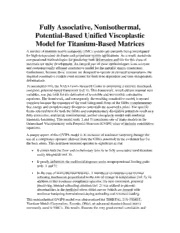
NASA Technical Reports Server (NTRS) 20050170432: Fully Associative, Nonisothermal, Potential-Based Unified Viscoplastic Model for Titanium-Based Matrices PDF
Preview NASA Technical Reports Server (NTRS) 20050170432: Fully Associative, Nonisothermal, Potential-Based Unified Viscoplastic Model for Titanium-Based Matrices
Fully Associative, Nonisothermal, Potential-Based Unified Viscoplastic Model for Titanium-Based Matrices A number of titanium matrix composite (TMC) systems are currently being investigated for high-temperature air frame and propulsion system applications. As a result, numerous computational methodologies for predicting both deformation and life for this class of materials are under development. An integral part of these methodologies is an accurate and computationally efficient constitutive model for the metallic matrix constituent. Furthermore, because these systems are designed to operate at elevated temperatures, the required constitutive models must account for both time-dependent and time-independent deformations. To accomplish this, the NASA Lewis Research Center is employing a recently developed, complete, potential-based framework (ref. 1). This framework, which utilizes internal state variables, was put forth for the derivation of reversible and irreversible constitutive equations. The framework, and consequently the resulting constitutive model, is termed complete because the existence of the total (integrated) form of the Gibbs complementary free energy and complementary dissipation potentials are assumed a priori. The specific forms selected here for both the Gibbs and complementary dissipation potentials result in a fully associative, multiaxial, nonisothermal, unified viscoplastic model with nonlinear kinematic hardening. This model (refs. 2 and 3) constitutes one of many models in the Generalized Viscoplasticity with Potential Structure (GVIPS) class of inelastic constitutive equations. A unique aspect of this GVIPS model is its inclusion of nonlinear hardening through the use of a compliance operator (derived from the Gibb's potential) in the evolution law for the back stress. This nonlinear tensorial operator is significant in that • It allows both the flow and evolutionary laws to be fully associative (and therefore easily integrated) (ref. 4). • It greatly influences the multiaxial response under nonproportional loading paths (refs. 1 and 5). • In the case of nonisothermal histories, it introduces an instantaneous thermal softening mechanism proportional to the rate of change in temperature (ref. 3). In addition to this nonlinear compliance operator, the new consistent, potential preserving, internal unloading criterion (ref. 2) was utilized to prevent abnormalities in the predicted stress-strain curves (which are present with nonlinear hardening formulations) during unloading and reversed loading. This nonisothermal GVIPS model was characterized for TIMETAL 21S (TIMET, Titanium Metals Corporation, Toronto, Ohio), an advanced titanium-based matrix commonly used in TMC's. The results illustrate the very good overall correlation and predictive capability of the model for a wide range of loading conditions--that is, tensile, cyclic, creep, step creep, step temperature, creep/plasticity interaction, and relaxation tests-- that are performed over the temperature range of 23 to 704 °C. Finally, the proposed model also was compared with a commonly accepted and employed Bodner-Partom (BP) viscoplastic model and found to be superior both in its predictive capabilities and numerical performance. Left: GVIPS correlation with experimental tensile data at 25, 300, 482, 565, and 650 °C, for a total strain rate of 8.33x10^-5. Right: Stress-time response of GVIPS prediction given relaxation tests at two temperatures (300 and 365 °C) and 1.9-percent strain. References 1. Arnold, S.M.; and Saleeb, A.F.: On the Thermodynamic Framework of Generalized Coupled Thermoelastic-Viscoplastic-Damage Modeling. Int. Jrl. Plasticity, vol. 10, no. 3, 1994, pp. 263-278 (NASA TM-105349, 1991). 2. Arnold, S.M.; Saleeb, A.F.; and Castelli, M.G.: A Fully Associative, Non-Linear Kinematic, Unified Viscoplastic Model for Titanium Based Matrices. NASA TM- 106609, 1994. 3. Arnold, S.M.; Saleeb, A.F.; and Castelli, M.G.: A Fully Associative, Non-Linear Kinematic, Unified Viscoplastic Model for Titanium Based Matrices. NASA TM- 106609, 1994. 4. Saleeb, A.F.; and Wilt, T.E.: Analysis of the Anisotropic Viscoplastic-Damage Response of Composite Laminates-Continuum Basis and Computational Algorithms. Int. J. Eng. Num. Meth., vol. 36, no. 10, 1993, pp. 1629-1660. 5. Arnold, S.M.; Saleeb, A.F; and Wilt, T.E.: A Modeling Investigation of Thermal and Strain Induced Recovery and Nonlinear Hardening in Potential Based Viscoplasticity. Jrl. Eng. Mater. Technol., vol. 117, 1995, pp. 157-167 (NASA TM-106122, 1993).
